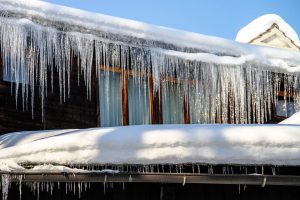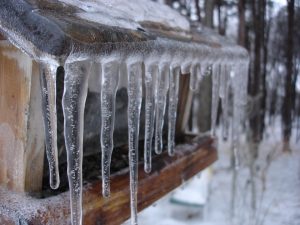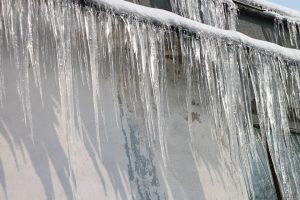Here are several ways to spot, prevent, and remove ice dams around your house or business.
What Is an Ice Dam?
Ice dams can be extremely damaging to your home or office. Taking just a few prevention tips can have an enormous difference in the amount of damage you experience each Winter. Ice Dams form when there is excessive melting snow freezes over night at the edge of your roofline. When there is an extended amount of time where extreme Winter Weather is present and proper snow removal is not done, the ice at the edge of your roofline can grow large enough to prevent water from draining off the roof when it does melt. This can cause the rain to not be able to drain off your roof and move underneath your roofs shingles. Eventually it could cause the water to back-up into the house.

Prior Prevention is key to preventing Ice Dams
There are some steps you can take prior to a Winter Storm that can go a long way towards preventing ice dams from occurring at your home or office. During the day snow melts when it is exposed to warmer temperatures and sun light. Each night the melted show has a tendency to remelt and build up around the edge of your roof. Here are a few tips to prevent this from happening.
- Properly Insulate your attic – Each fall it is important for you or a trained professional to inspect your attic for proper insulation to help prevent warmth from escaping through ceilings.
- Prevent air leaks – Thoroughly check and seal any openings where warm air or heat could escape from your attic. Keeping more of the warm air in can prevent parts of your roofline from continuing to allow melted snow to refreeze.
- Ensure proper ventilation – If need be, it may be beneficial to increase the number or size of vents in the attic and on the top floor of your building. These vents allow cold air to properly circulate and flush warmer air in to the proper areas of your house.
- Install a water-repellent membrane under shingles – When building a new house or when replacing parts of your roof, it can be very beneficial to install a water-repellent membrane underneath the roofs’ shingles.

How to Remove an Ice Dam
Removing an ice dam from your roof immediately after spotting one is essential to preventing damage to your home or office. Calcium Chloride is a great product to use to speed up the process of removing any potential ice dam. Our partners at Travelers Insurance came up with this 5 step process for removing an ice dam.
Step 1. Using a roof rake, remove snow 3-4 feet from the edge of your roof, being careful not to damage the roof covering or to allow snow to build up around walking paths or to block emergency exits.
Step 2. Use a calcium chloride ice melt product, which you can generally purchase from your local hardware store. Be sure not to use rock salt or sodium chloride, which can damage your roof.
Step 3. Fill a nylon stocking with the calcium chloride ice melt.
Step 4. Safely place and position the calcium chloride-filled nylon stocking vertically across the ice dam so that it can melt a channel through the ice.
Step 5. Cover and protect any shrubbery and plants with lightweight tarps near the gutters or downspouts for the duration that the calcium chloride stockings remain in place. This is important because the calcium chloride-saturated water dripping from the roof may damage the shrubbery and plants.

Tips to Prevent Ice Dams from creating in the future
Ice dams can frequently form despite your best efforts to keep your property safe. Keeping the entire building at a safe temperature is a good place to start when attempting to prevent ice dams. It is equally important to monitor the weather and maintain your roof throughout the coldest portions of the Winter. During these months your property may need additional protection against ice dams. Some of the best steps you can take include:
- Keep your gutters clean – In order to prevent water from accumulating and freezing inside your gutters, start in the fall by adequately cleaning leaves, debris and snow accumulation from your gutters and downspouts.
- Remove snow quickly after each storm – As soon as it is possible for your to safely remove the snow from your roof after a storm the better it is to prevent ice dams from forming. There are tools like roof rakes that are designed specifically for this purpose. Whenever possible, clear the snow on your roof for about three to four feet from the edge of your roof. Snow accumulation along the edge of your roof increases the likelihood of an ice dam developing, which prevents water from draining off the roof. This water can then back up underneath roof shingles and make its way into your home.
- Remove Ice Dams early and often – During a Winter Storm, it is important to check your roof often to spot any trouble spots that may be forming. Removing these spots earlier in the storm can go a long way towards saving you property from facing immense damage down the road.
